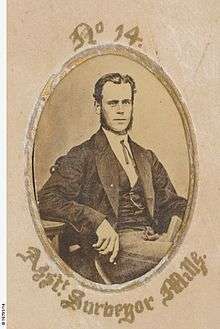William Mills (surveyor)
William Whitfield Mills (19 November 1844 – 18 August 1916), usually referred to as "W. Whitfield Mills" or "W. W. Mills", was an English surveyor of the Australian Overland Telegraph Line who is best known for naming a waterhole in Central Australia Alice Spring, from which the town of Alice Springs now takes its name. He also named Heavitree Gap as a tribute to his old school in Devon, England.
William Whitfield Mills | |
|---|---|
 W.W Mills | |
| Personal details | |
| Born | William Whitfield Mills 19 November 1844 Plymouth, England |
| Died | 18 September 1916 (aged 71) Widgiemooltha, Western Australia |
| Spouse(s) | Mary Jane Mullen |
| Children | Alice Thornton, Ethel May |
| Occupation | Surveyor |
Early life
Mills was born on 19 November 1844 at Plymouth in England. He went to school at Heavitree School in Devon.[1] Mills immigrated to Australia on board the Atlanta from England, arriving in South Australia on 8 April 1866 at the age of 21.[2]
Goyder's Expedition
Mills was a surveyor on George Goyder's mission to survey a northern capital Palmerston, later renamed Darwin. He arrived on the Moonta on 5 February 1869 leaving just short of a year later, the team having surveyed more than 2700 square kilometres of land.[2]
Surveying the Overland Telegraph Line
On 5 September 1870, he joined Charles Todd's party to build the central section of the Overland Telegraph Line.[2] On 7 March 1871, Mills and his companion Gilbert McMinn, having found a gap in the McDonnell Ranges through which to feed the telegraph line, and which he named Heavitree Gap, then came across a string of waterholes along what is now called the Todd River, which were already frequented by local Arrernte people. Mills named one Alice Spring, after the wife of Charles Todd, from which the town of Alice Springs now takes its name.[2]
Later life
Mills married Mary Jane Mullen on 24 March 1879.[3][4] They had two daughters Alice Thornton and Ethel May.[5][6][1]
After completion of the telegraph line, Mills returned to the Northern Territory to work in mining and undertake further surveying.[7][8][9][10] In the early 1880s, he managed a camel transport company carrying freight from Farina to Peake and Charlotte Waters. He delivered 30 camels from Beltana Station to Northampton in Western Australia for Sir Thomas Elder. He went across the centre of Australia on the Canning Stock Route before heading to Northampton.[11][12] They went for long periods without water but after 25 weeks, completed the journey.[13]
Mary Jane died on 1 October 1888 at just 30 years of age. The Mills children were then brought up by extended family,[1] while Mills spent time in Broken Hill before eventually moving to Western Australia.[14]
Mills died on 18 August 1916 at the age of 72. He is buried in the Widgiemooltha Cemetery in Western Australia.[1]
Mills Street in East Side in Alice Springs is named after Mills.[15]
References
- "William Whitfield Mills". Flinders Ranges Research. Retrieved 23 May 2017.
- Traynor, Stuart (2016). Alice Springs: From singing wire to iconic outback town. Mile End, South Australia: Wakefield Press. ISBN 9781743054499.
- "Family Notices". The South Australian Advertiser (Unknown) ed.). 24 March 1879. p. 16. Retrieved 23 May 2017 – via National Library of Australia.
- "Family Notices". Evening Journal. XI (3090). Adelaide. 27 February 1879. p. 2 (SECOND. Retrieved 23 May 2017 – via National Library of Australia.
- "Family Notices". South Australian Register. XLVI (10, 934). 29 November 1881. p. 4. Retrieved 23 May 2017 – via National Library of Australia.
- "Family Notices". South Australian Register. L (12, 016). 19 May 1885. p. 4. Retrieved 23 May 2017 – via National Library of Australia.
- "Advertising". South Australian Register. XXXVIII (8220). 22 March 1873. p. 1. Retrieved 23 May 2017 – via National Library of Australia.
- "Advertising". Evening Journal. XI (3190). Adelaide. 28 June 1879. p. 3. Retrieved 23 May 2017 – via National Library of Australia.
- "THE EXPLORER". Adelaide Observer. XLII (2303). 21 November 1885. p. 13. Retrieved 23 May 2017 – via National Library of Australia.
- "THE NORTHERN TERRITORY". South Australian Chronicle and Weekly Mail. XVI (804). 10 January 1874. p. 7. Retrieved 23 May 2017 – via National Library of Australia.
- "SIX MONTHS ON A CAMEL IN CENTRAL AUSTRALIA". South Australian Register. XLIX (11, 585). 1 January 1884. p. 1 (SUPPLEMENT TO THE SOUTH AUSTRALIAN REGISTER.). Retrieved 23 May 2017 – via National Library of Australia.
- "THE TRAVELLER". Adelaide Observer. XLI (2206). 12 January 1884. p. 41. Retrieved 23 May 2017 – via National Library of Australia.
- "ARRIVAL OF MR. MILLS AND PARTY AT NORTHAMPTON". Adelaide Observer. XL (2200). 1 December 1883. p. 8. Retrieved 23 May 2017 – via National Library of Australia.
- "ARRIVAL OF MR. MILLS AND PARTY AT GERALDTON". Evening Journal. XV (4534) (SECOND ed.). Adelaide. 27 November 1883. p. 3. Retrieved 23 May 2017 – via National Library of Australia.
- "WHY THESE NAMES". Centralian Advocate. VII (316). Northern Territory, Australia. 26 June 1953. p. 2. Retrieved 22 May 2017 – via National Library of Australia.